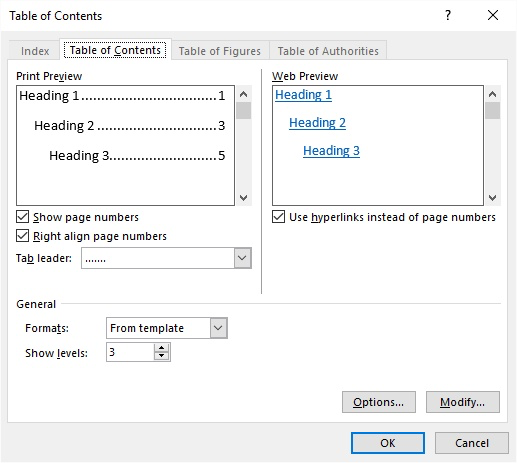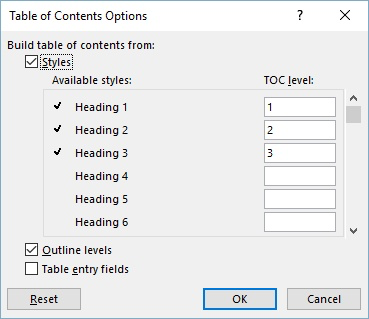Please Note: This article is written for users of the following Microsoft Word versions: 2007, 2010, 2013, 2016, 2019, 2021, and Word in Microsoft 365. If you are using an earlier version (Word 2003 or earlier), this tip may not work for you. For a version of this tip written specifically for earlier versions of Word, click here: Using Multiple Tables of Contents.
Written by Allen Wyatt (last updated May 25, 2024)
This tip applies to Word 2007, 2010, 2013, 2016, 2019, 2021, and Word in Microsoft 365
Word allows you to include multiple tables of contents in a single document. Thus, you can have a table of contents for each chapter of a book, even if all the chapters are in the same document.
The easiest way to create multiple tables of contents is to use styles. What you want to do is to create a set of styles for the headings you want included in each TOC. For example, you might use styles named “Chapter1Heading1”, “Chapter1Heading2”, and so on for the first chapter, and “Chapter2Heading1”, etc., for the second chapter. Once you are done creating all the styles for your headings, you'll need to apply those styles to the actual headings in your document. (How you create and apply styles is beyond the scope of this tip, but has been covered extensively in other WordTips.)
With your styles defined and applied to all the appropriate headings in your document, you are ready to generate the tables of contents. You can do this by following these steps:

Figure 1. The Table of Contents tab of the Table of Contents dialog box.

Figure 2. The Table of Contents Options dialog box.
You should note that if, before following the above steps, your document already contains a TOC that was generated from a building block (done by selecting one of the predefined TOC styles), when you close the Table of Contents dialog box in step 8 the previous TOC is selected and you are asked if you want to replace it with the new TOC. In most instances you won't want to do that, you'll want to add the new TOC to any you've already defined.
There is another approach you can use that is well suited if you simply want to add a second TOC that applies to just a small portion of your document. This approach relies on the use of bookmarks. Follow these general steps:
{ TOC \o "1-2" \h \z \u }
{ TOC \o "1-2" \h \z \u \b PARTx }
WordTips is your source for cost-effective Microsoft Word training. (Microsoft Word is the most popular word processing software in the world.) This tip (10080) applies to Microsoft Word 2007, 2010, 2013, 2016, 2019, 2021, and Word in Microsoft 365. You can find a version of this tip for the older menu interface of Word here: Using Multiple Tables of Contents.

Create Custom Apps with VBA! Discover how to extend the capabilities of Office 365 applications with VBA programming. Written in clear terms and understandable language, the book includes systematic tutorials and contains both intermediate and advanced content for experienced VB developers. Designed to be comprehensive, the book addresses not just one Office application, but the entire Office suite. Check out Mastering VBA for Microsoft Office 365 today!
Word allows you to easily add a table of contents to your documents. If you find that some of your document headings ...
Discover MoreGenerating a table of contents is easy in Word. Changing how that table of contents looks is also easy, provided you ...
Discover MoreThe TOC (Table of Contents) is generated by a field. This field may be updated in a macro using a single command line.
Discover MoreFREE SERVICE: Get tips like this every week in WordTips, a free productivity newsletter. Enter your address and click "Subscribe."
There are currently no comments for this tip. (Be the first to leave your comment—just use the simple form above!)
Got a version of Word that uses the ribbon interface (Word 2007 or later)? This site is for you! If you use an earlier version of Word, visit our WordTips site focusing on the menu interface.
Visit the WordTips channel on YouTube
FREE SERVICE: Get tips like this every week in WordTips, a free productivity newsletter. Enter your address and click "Subscribe."
Copyright © 2026 Sharon Parq Associates, Inc.
Comments